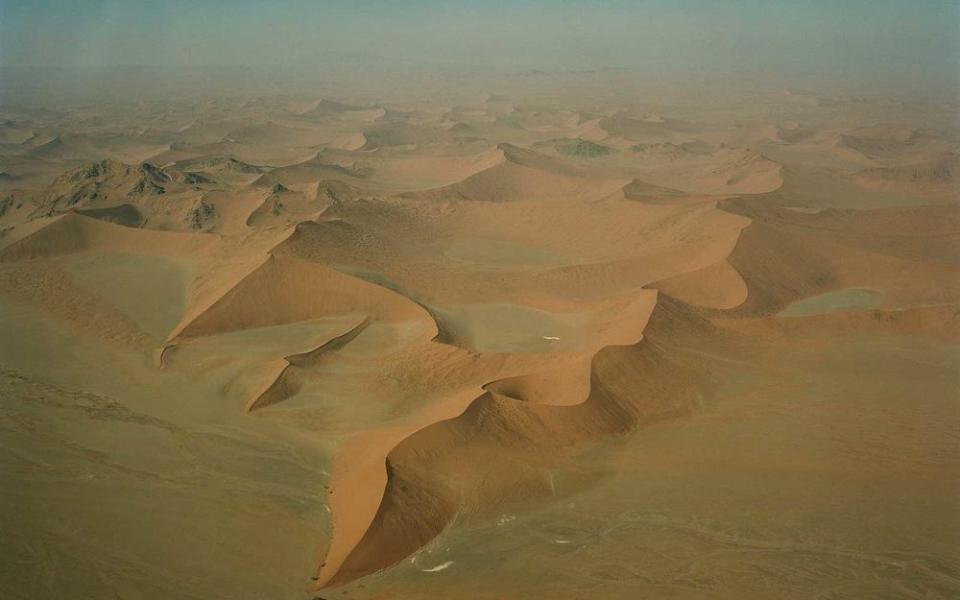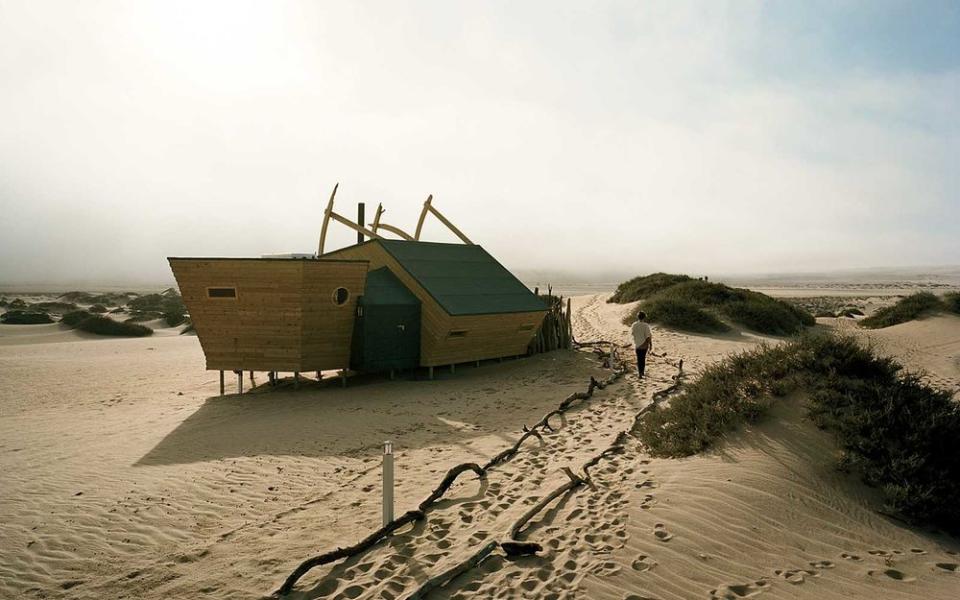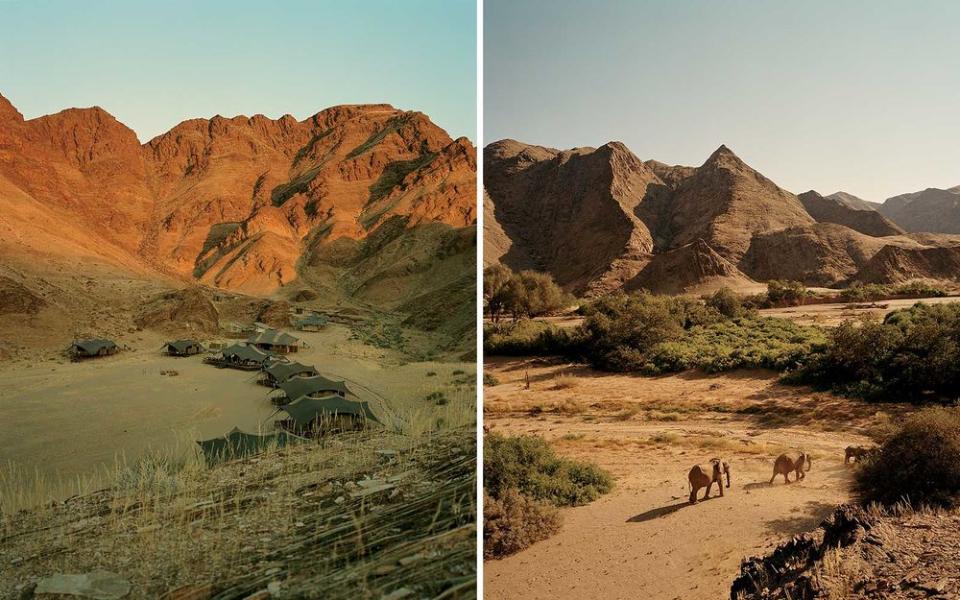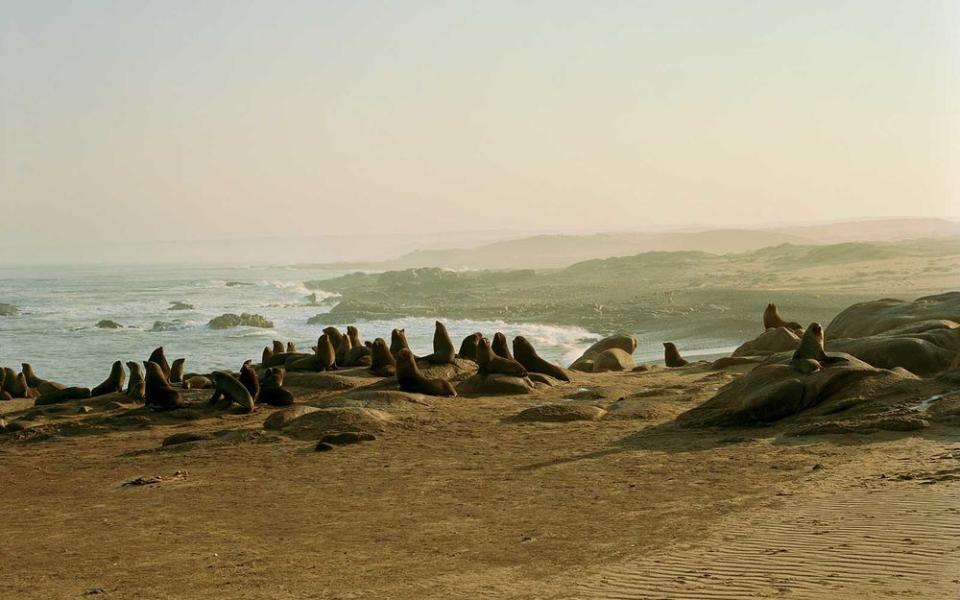Namibia Has the Most Spectacular Desert Landscapes in the World — Now It Has Luxury Lodges to Match
I assumed there would be silence in the desert; I was wrong. I thought that little of interest could survive in such a hostile place, but I was wrong again. Although I was born and raised in Africa, Namibia has changed the way I see the continent, and how I connect with it. It has rekindled the awe for Africa in me.
The Namib is the oldest desert in the world, an almighty sea of sand running for almost a thousand miles along Namibia’s Atlantic coastline. With few roads running to it or through it, the desert is largely inaccessible, and almost entirely uninhabited by humans. Yet somehow life thrives there — in astonishing shapes and forms.
In the Namib I was serenaded by duetting bokmakierie birds and entertained by prancing ostriches in black tutus. There were wild melons growing in the sand, some tiny enough to furnish a dollhouse, some as big as beach balls. I learned to recognize the shepherd’s tree, which gives off a smell like a sewer but can sustain everything from insects to human beings with its roots, berries, leaves, and bark. I watched Hartmann’s mountain zebras strut and snort on vast, open plains, and I tracked desert-adapted elephants across dry riverbeds.
My adventure began — as virtually all safaris in Namibia do — in the capital, Windhoek. There I was joined by James Kydd, one of Africa’s finest private safari guides and a man with a profound love for wild, open spaces. Together, Kydd and I flew to Sossusvlei, a part of the Namib famous for its immense red sand dunes — some of the tallest in the world. As we flew over them, the supremely well-traveled Kydd told me Namibia is one of his all-time favorite places. Looking out of the aircraft window, it was obvious why.

We began by flying high above the pleats and folds of the Khomas Hochland mountains, before leveling out over a highland plateau punctuated with thorn trees, isolated settlements, and rocky inselbergs. Next, we swooped south over the great escarpment that separates the highlands from the desert — the magnificent, flat-topped Gamsberg Mountain to the east, the spectacular gorges and ravines of the Naukluft mountain range to the west. Then we crossed the low gravel plains of the Namib Desert and, finally, the colossal sand pyramids of Sossusvlei.
We were booked into the newest camp in the region, Sossus Under Canvas, which stands on the Namib Tsaris Conservancy — a private wildlife sanctuary carved from 60,000 acres of former farmland. The majority owner, a Namibian property developer named Swen Bachran, bought the land eight years ago and has worked hard to improve roads, take down fences, and install water holes for the animals he has reintroduced, which include zebras, cheetahs, and giraffes. Since Bachran established the park, leopards and hyenas have returned to the area, and herds of antelope — Namibia’s iconic oryx and ubiquitous springbok among them — have begun proliferating.
In addition to being a keen conservationist, Bachran has a strong eye for property. The conservancy is a wonderfully handsome tract of land with both immense plains and a high plateau, from which there are breathtaking views of Sossusvlei. Rain had come to the area a couple of months before we arrived, ending a five-year drought. As a result, the lowlands were coated in feathery grass that shimmered in the cool east wind, as iridescent as the flicker on a silver screen.
The camp itself sits easy in the landscape, tucked into a natural amphitheater at the bottom of a cliff with the prairie stretching out before it. Its eight guest tents have floors and furniture built with reclaimed wood and roofs tiled with panels made from recycled oil drums. The effect is surprising, elemental, and beautiful. As the only camp on the reserve, Sossus feels completely private and imparts an extraordinary sense of exclusivity and freedom to its guests.
Franco Morao, a young Namibian with a keen mind and a gentle manner, was our host and local guide. Accompanied by Morao and Kydd, I spent my days exploring the reserve on foot, meeting the cast of astonishing characters that thrives in this arid environment. First up was the quiver tree, the grande dame of the Namib Desert. A succulent with a crown of bulbous branches covered in a thick white powder, this species grows on even the most unforgiving rocky ridges of the escarpment. The nomadic San people used to hollow out branches to use as containers for their arrows — hence the name. In times of drought, the trees are known to self-amputate, sacrificing a branch for the survival of the whole. In the evenings at Sossus, as color drained from the China-blue skies, the quiver trees stood out like luminous sentinels around the desert prairies, guardians of all they surveyed.
The Namib Desert is also home to some of the biggest bird’s nests in the world, which are built by colonies of sociable weaverbirds in the style of thatched apartment buildings. Cool during the day and warm at night, they provide year-round dwellings for up to 500 birds at a time, and the excited chatter of these weaverbird colonies returning after a day out hunting created a cheerful soundtrack for our evenings at the lodge.
Related: 6 Gorgeous Desert Destinations for Soaking Up the Sun This Winter
Morao showed me how to set fire to a bushman’s candle, an inconsequential shrub that, when ignited, crackles into flames to emit a pure, white light. That night, Kydd put a black husk he’d found while walking in a jar of water; by morning it was fat and green, a miracle expressed by its colloquial name: the resurrection plant.
Within a day, I could make out the unmistakable tap of a tok-tokkie beetle as it serenaded a potential mate. Tok-tokkies have adapted to the desert by becoming earthbound, their wings fused into a hard shell with ridges that have evolved to collect moisture from fog drifting in from the ocean. By raising their long back legs and performing a headstand on the sand, they let the accumulated droplets run down their shells and trickle into their mouths. Once seen, never forgotten.
Such interesting new friends — and potential foes such as scorpions and snakes, a particular interest of Kydd’s — were introduced to me daily, and in their presence I have never felt so ordinary or domesticated. A tiny indentation in the sand revealed itself to be an insect trap dug by an ant lion larva, a creature just a fraction of an inch long but with formidable pincers that eventually metamorphoses into an ethereal flying insect, seen mainly at night. As a child growing up in Zimbabwe, I would torment ant lion larvae, jabbing at them with grass until their pincers gripped; out in the Namib Desert I finally learned about their worth in the world.
On my penultimate day at the lodge, we set off to visit Sossusvlei. Vlei is Afrikaans for “salt pan,” while sossus translates from the Namib language as “dead end.” The name refers both to a part of Namib-Naukluft Park and to a specific dry claypan within it — formed when the Tsauchab river became blocked by sand, coming to a halt before reaching the Atlantic Ocean.
There is only one road to Sossusvlei in the park. It runs for about 40 miles along the dry floodplain of the Tsauchab, soaring red sand dunes rising on either side like the parting of the Red Sea. In the early morning, the road was swathed in a gauze of fog coming in from the Atlantic. As the first rays of sunlight hit the tops of the symmetrical dunes with astonishing precision, their ridges were lit up like a row of smoke signals.
Sossusvlei is the biggest of four claypans in the area, and the only one ever to flood. The most striking, however, is undoubtedly Deadvlei. In this parched, arid place stand the skeletons of camel thorn trees, dead since the 11th century. In their branches, flocks of Cape crows stand watch, just as they have for hundreds of years.
Möwe Bay Stands on the edge of one of southern Africa’s last great wildernesses: the Namib Desert’s Skeleton Coast National Park and, beyond it, the remote region of Kaokoland. The desolate town was named after the German cruiser Moewe, which put a landing party ashore in 1884 with instructions from their leader, Otto von Bismarck, to seize the coastline, beginning a German occupation that lasted until the end of World War I. A succession of expeditions followed, each intent on uncovering the secret wealth of minerals and diamonds thought to be hidden in this forbidding landscape, but most of it came to nothing.
Fittingly for an entry point to such a stark, empty place, there is little more to this outpost than a solitary national park office and a dusty, single-room museum stuffed with skulls and rusty relics of the sea. But for anyone intrigued by the strange and the beautiful, Möwe Bay is a study in mournful longing, imparting as it does a sense of having reached the very edge of the known world.
The air here is heavy with the smell of the Cape seals that have colonized the rocky seafront. As the morning mist rolled in, Kydd and I stood and watched as the seals happily honked and flapped and slithered in and out of the churning sea. A pair of black-backed jackals skulked behind them, circling for vulnerable pups as their mothers basked, oblivious to any danger, heads tilted toward the warming sun.
After an hour or so in Möwe Bay, it was time to head up the Skeleton Coast: an unbroken stretch of deserted shoreline pounded by the Atlantic and littered with the shattered remains of ships and whales, for which the region is named.

Shipwreck Lodge, the only camp in Skeleton Coast National Park, lies 28 miles up the coast from Möwe Bay, at the mouth of the Hoarusib River. There are no roads; access to the property is via four-wheel-drive, along limitless shingle beaches and over a formidable roller coaster of sand dunes. The logistics of building a camp somewhere this remote are mind-boggling; erecting one on shifting sand makes things more challenging still. Shipwreck Lodge is no ordinary camp, either: a jaunty row of wooden cabins, seemingly marooned in undulating waves of white sand like upended shipwrecks, each as wistfully romantic as a child’s doodle.
The next morning, Kydd and I climbed the highest dune we could find to watch the sun rise over the whirls of apricot-colored sand below. Later, we were joined by a local guide, Niclas Rungondo, for a drive up to the lip of a dune. We paused at the top before coasting down the other side; as we did so, the dune emitted a loud groan, as if voicing its discomfort. I was told the sound occurs when sand moves down crescent-shaped dunes in very precise conditions — though what these are, nobody can quite agree. Many years ago, Marco Polo wrote of the “singing dunes” of the Gobi Desert in northern China, which produce an otherworldly sound he had no hesitation in attributing to desert spirits. For one brief moment, as that eerie sound echoed out over the Namib Desert, I was moved to agree with him.
When rain does come to this desert, the Hoarusib River floods and flows into the Atlantic Ocean. But even in times of drought, residual moisture in the ground sustains a surprising amount of greenery. The next morning we drove slowly along the Hoarusib’s wide floodplains, which were surrounded by steep canyons of black and red volcanic rock topped with tall Makalani palms. Desert-adapted elephants are known to follow dry riverbeds, digging wells from which to drink, but we could find no trace of any. Instead, we followed the tracks of a brown hyena and stopped to examine the slithery indentations a blind golden mole had left as it burrowed along in the sand.
As the sun reached its zenith, we stopped at one of the “clay castles” that line the river valley — fantastical formations created by centuries of erosion. We explored their echoing, khaki canyons, where the bleached bones of antelope lay scattered. Kydd found a bat, stunned by heat exhaustion, lying at the entrance to a cave. He slowly dripped water into its mouth. Revived, it flew off, circling above us in a triumphant salute.
On our way back to camp, we joined little wagtails and sleek Egyptian geese at a miniature oasis, an apparition of glittering water and bright green reeds. I realized the day had passed without our encountering another person or hearing another human sound. For 10 precious hours we’d had the ancient Hoarusib River valley completely to ourselves, a rare and exquisite privilege.

Inland from the Skeleton Coast lies Kaokoland, another of Namibia’s remote wildernesses, which is inhabited only by a smattering of indigenous Herero and Himba communities. Our base in this far-flung corner of the Namib Desert was Hoanib Valley Camp, managed by Natural Selection — the same safari company behind Shipwreck Lodge. The two camps are linked by a full day’s drive, with Möwe Bay as a staging post in between. The long journey turned out to be an unforgettable safari through the changing northern Namib Desert landscapes, from the high, windswept dunes of the coast to low floodplains and then the wide expanse of the Hoanib River valley, shaded with tall ana trees.
The camp itself is sheltered beneath an imposing granite outcropping that overlooks the river valley. With only six tents set on raised wooden platforms, it is an intimate and wonderfully peaceful retreat, staffed with the kindest people. Our guide, Frank Ndataiziro Kasoana, spent his childhood herding goats and cattle in a village not far away, so he knew the land and how to read it better than anyone.

The valley is famous for its wildlife, and we encountered a herd of elephants before even reaching camp. Led by a wise-looking matriarch, the family group appeared from behind a thick grove of thorn trees to amble along the sandy valley floor, a near-silent caravan of swaying trunks and fly-swatting tails. Continuing on our way, we came across a herd of handsome oryx, then a pair of graceful giraffes grazing in a shady glade.
Kydd had heard there were lions in the area, and it didn’t take long before we spotted fresh tracks in the milk-chocolate mud of the riverbed, heading upstream toward the nearest village. Not long ago, a group of five lions, a band of brothers known as the Five Musketeers, had begun killing cattle in the villages. Despite being collared and monitored by Philip Stander, a respected lion expert and conservationist, all five were eventually shot or poisoned by frustrated herdsmen. With fewer than 150 lions left in the Namib Desert, human-wildlife conflict is a big issue, and a difficult one to manage. “It is a very old, frustrating problem,” said Kasoana, who, as a former cattle herder, knows both sides of the argument only too well.
Hoanib Valley Camp was built in partnership with local communities like Kasoana’s and the Giraffe Conservation Foundation, which often conducts research in the area. After dinner one night, the foundation’s codirector, Stephanie Fennessy, shocked me with the fact there are fewer than 100,000 giraffes left in the wild today, with numbers down 40 percent over the past three decades. Her husband, Julian Fennessy, is codirector of the foundation, and earned his Ph.D. studying the desert-adapted giraffe in the Hoanib River valley. Fennessy can read the patterns on the coats of the giraffes like fingerprints. He told me that he fears a “silent extinction” of the elegant creatures is under way — something he is fighting to reverse, in part by raising awareness of their plight. Certainly the opportunity to get to know these rare creatures as individuals is unique to Hoanib Valley Camp, where they luxuriate in near-celebrity status and happily oblige their fans with frequent sightings.
Before we left the Namib Desert, Kasoana took us to see the Herero village where he grew up, a huddle of tin-roofed shacks where the women wear cheerful cotton headdresses and long dresses which, remarkably, are still modeled on those worn by their colonial mistresses. Along the way, we stopped at a nearby settlement of seminomadic Himba people and were shown around their cattle and goat pens. We also saw the immaculate interiors of their domed huts made from mud and cow dung.
So far the Himba have managed to resist change and are determined to preserve their traditional way of life. The women were naked except for animal skins and layer upon layer of jangling jewelry. They color their skin red by mixing butter with ocher pigment, and daub their braided hair with more thick ocher. Kasoana explained that the government has introduced mobile schools in an attempt to corral the Himba into the education system, but herding goats and cattle still takes precedence and is taught from an early age.
I had been anxious about visiting the Herero and Himba villages, concerned that the experience might feel inauthentic or uncomfortable. I needn’t have worried. Seldom have I met a more beautiful, proud, or courteous group of people. I felt welcomed and left enlightened, relieved to know that beyond the reach of most people’s ideas of civilization, there remain communities that seem so at one with the world as they know it.
An Unforgettable Adventure in Namibia
Give yourself plenty of time to explore this country, as the distances are vast. Visiting the Namib Desert is all about taking in the epic landscapes and unique flora and fauna. For more traditional wildlife viewing, consider a stop at Etosha National Park, with its famous salt pans, or the Okavango Delta in neighboring Botswana.
Getting There and Around
The easiest flight connections to Windhoek, the capital, are through Frankfurt or Johannesburg. Upscale lodgings are typically accessed via light aircraft transfers, which are efficiently operated and offer fantastic views.
Windhoek
Most visitors spend a night in Windhoek before or after a safari, and the new lodge Omaanda (doubles and savannah excursion from $900, all-inclusive), just outside of town, is the place to stay. Its French owner, Arnaud Zannier, was introduced to Namibia by Angelina Jolie, whose friends, Marlice and Rudie van Vuuren, own the wildlife sanctuary Na’ankusê outside Windhoek. A little later, Zannier bought 22,000 acres adjacent to the van Vuurens’ land. His new 10-bedroom lodge there is an upscale take on traditional dwellings with conical thatched roofs. The interior design is impeccable, the breakfast is the best in town, the swimming pool is heated, and there is a small spa.
Sossusvlei
The Namib Desert is protected by a number of national parks. The area generally referred to as Sossusvlei is in the Namib-Naukluft Park, in the west of the country. With only one lodge and a basic campsite in the park itself, a number of private reserves have opened on its border, including the well-established NamibRand Nature Reserve and the relatively new Namib Tsaris Conservancy, where I stayed at Sossus Under Canvas (doubles from $800, all-inclusive). Also on the property is Nest at Sossus (from $1,300 per person, all-inclusive), a remarkable private house conceived by South African artist Porky Hefer. The park entrance to Sossusvlei is about a 40-minute drive from the conservancy. Most visitors arrive to take photographs of the dunes and the claypans at dawn. Quieter excursions include exploring the open plains and the Tsaris Mountains.

Skeleton Coast
This stretch of coast north of Swakopmund, named after the shipwrecks and whale carcasses strewn along its shores, is about as wild and remote as it gets. Just inland, the Kaokoland region is similarly untouched and underpopulated. I stayed at two new camps in the area managed by Natural Selection, a collective run by some of the best-known names in southern Africa’s safari industry. Shipwreck Lodge (doubles from $1,379, all-inclusive) is the only camp in Skeleton Coast National Park. It’s a great base for climbing dunes and exploring the Hoarusib River valley. The six-tent Hoanib Valley Camp (doubles from $1,216, all-inclusive) is built on community-owned land just outside the park, where you’ll likely spot desert-adapted elephants and giraffes.
Tour Operator
My trip was organized by Michael Lorentz (ml@passagetoafrica.com; 27-21-447-0053), a member of the A-List, Travel + Leisure’s collection of the world’s top travel advisors. I was accompanied by James Kydd, a private guide who proved invaluable both for his knowledge and for his companionship. A similar 10-day itinerary with Lorentz’s company, Passage to Africa, including a private guide and all internal flights and transfers, starts at $46,240 for two people.

